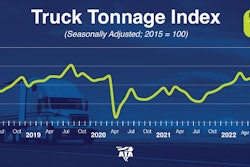Despite stumbling freight, higher finance costs and restrictive credit availability, ACT Research continues to see healthy sales and build trends for Class 8 trucks this year – even in the face of a likely recession potentially inbound by June.
Pent-up vehicle demand and still historically elevated carrier profits early this year continue to prop up demand for new equipment, ACT’s latest release of the North American Commercial Vehicle OUTLOOK reported.
“We continue to expect a recession in the first half of this year leading to an incremental year-over-year decline in 2023 Class 8 build from 2022 as freight market weakness increasingly weighs on demand into the year’s second half," said Kenny Vieth, ACT’s President and Senior Analyst. "While the Fed may continue raising interest rates in 25-basis point increments longer into 2023 than currently envisioned, we do not believe the pace of rate hikes will be aggressive enough to sharply impact commercial vehicle market performance.”
Part of what is continuing to fuel demand for trucks and trailers is a freight environment that now seems unlikely to reach the kind of depths many forecasted near the end of 2022.
Truckstop.com's semi-annual freight broker survey shows brokers are less pessimistic than anticipated given the challenges the industry faces from declining volume and rate pressure. Broker demand sentiment is rather upbeat, with about 41% of respondents citing an uptick in volume in the second half of 2022 compared with a year earlier, about 6 percentage points lower than in its first half of 2022 survey. Though more respondents reported growth, the magnitude of declines were greater.
"Freight brokers appear unfazed by the collapse in spot truckload rates and the effects of moderating economic activity on demand, contractual rates and gross margins," said Lee Klaskow, senior freight transportation and logistics analyst at Bloomberg Intelligence. "Only 12% of respondents expect gross margins to contract over the next six months."
Brokers also remain relatively optimistic about demand growth. About 49% of those surveyed in the Truckstop and Bloomberg Intelligence Survey expect demand growth over the next six months versus 45% in the first half of last year, and 76% in the second half of 2021.
The rosy (or less gloomy, rather) outlook for freight is supported, Veith said, by a consistent demand for equipment as fleets seek to get back to a regular trade cycle.
“The industry enters 2023 with a fair amount of visibility, thanks to a robust backlog,” Vieth said. “While down year-over-year, the December-ending Class 8 backlog represents the fourth highest year-end backlog on record. With this as context, our call for strong production in 2023 is hardly a stretch. That said, we do expect softening, as lower freight volumes and rates, higher costs, improved equipment availability, and the gradual exhausting of pent-up demand begin to exert downward demand pressure.”
Brokers are split about where rates are headed, even as pessimism grows. Spot rates (excluding fuel surcharges) have fallen 24% over the past 12 months after peaking near 2021's end. About 34% expect rates to decrease in the next six months, while 28% see them rising. The group is far less optimistic about the ability to raise contract rates with shippers over the next six months. About 22% of brokers polled expect to boost rates -- 14 percentage points below the survey conducted in the first half of 2022 and 34 percentage points behind the second half 2021 report.
Spot rates in the van segments continue to track generally with seasonal expectations with only a slight separation from the five-year average, according to data from Truckstop and FTR Transportation Intelligence for the week ending Feb. 10. Despite headwinds like a weakened residential construction market and a softening manufacturing sector, flatbed load activity has increased every week of 2023 and stands at the highest level since August.
Since late last year, the expectations for 2023 have been told in two parts: a poor first half of the year followed by a bounce back in the second half. However, Jason Miller, associate professor of supply chain management at Michigan State University, said there needs to be a rebound in manufacturing activity – the source for ~58% of trucking ton-miles – for that to occur, "and until single-family housing recovers, I’m not sure a good case can be made on that front."













